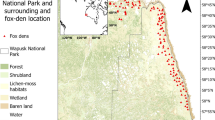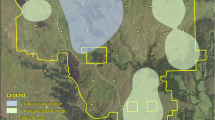Abstract
We compared resource utilization of two insular endemic mammalian carnivores, the island spotted skunk and island fox, along niche dimensions of space, food, and time on Santa Cruz Island. We predicted that resource use by foxes and skunks would differ along one or more niche dimensions, and that both species would have broader niches or higher densities compared with mainland relatives. Island foxes and island spotted skunks differed to some extent in habitat use, diets, and circadian activity, which may account for their long-term coexistence. Nonetheless, substantial overlap between skunks and foxes in spatial, dietary, and temporal dimensions suggests that competition between the two species does occur. Moreover, competition may be asymmetric, affecting skunks more than foxes. Compared with mainland foxes, island foxes have smaller body size, smaller home range, increased population density, increased diurnal activity, and behavior that is more highly inquisitive and less flightprone all common features of insular faunas. Island skunks, however, apparently have not developed these changes, perhaps due to asymmetric competition with foxes in conjunction with severe ecosystem disturbances caused by feral sheep.
Similar content being viewed by others
References
Alcover JA, McMinn M (1994) Predators of vertebrates on islands. Bioscience 44:12–18
Beatty SW, Licari DL (1992) Invasion of fennel (Foeniculum vulgare) into shrub communities on Santa Cruz Island, California. Madroño 39:54–66
Bloeker JC von Jr (1967) The land mammals of the southern California Islands. In: Philbrick RN (ed) Proceedings of the symposium on the biology of the California Islands. Santa Barbara Botanic Garden, Santa Barbara, pp 245–263
Brown JH, Gibson AC (1983) Biogeography. Mosby, St. Louis
Brown JH, Munger JC (1985) Experimental manipulation of a desert rodent community: food addition and species removal. Ecology 66:1545–1563
Byers CR, Steinhorst RK, Krausman PR (1984) Clarification of a technique for analysis of utilization-availability data. J Wildl Manage 48:1050–1053
Carlquist S (1974) Island biology. Columbia University Press, New York
Case TJ, Bolger DT (1991) The role of interspecific competition in the biogeography of island lizards. Trends Ecol Evol 6:135–139
Case TJ, Gilpin ME (1974) Interference competition and niche theory. J Wildl Manage 27:9–24
Crabb WD (1941) Food habits of the prairie spotted skunk in southeastern Iowa. J Mammal 22:349–364
Crooks KR (1994a) Demography and status of the island fox and the island spotted skunk on Santa Cruz Island, California. Southwest Nat 39:257–262
Crooks KR (1994b) Den-site selection in the island spotted skunk of Santa Cruz Island, California. Southwest Nat 39:354–357
Crooks KR, Van Vuren D (1994) Conservation of the island spotted skund and island fox in a recovering island ecosystem. In: Halvorson WL, Maender GJ (eds) The fourth California islands symposium: update on the status of resources. Santa Barbara Museum of Natural History, Santa Barbara, pp 379–386
Crowell KL (1983) Islands-insight or artifact?: population dynamics and habitat utilization in insular rodents. Oikos 41:442–454
Crowell KL, Pimm SL (1976) Competition and niche shifts of mice introduced on to small islands. Oikos 27:251–258
DeBach P (1966) The competitive displacement and co-existence principles. Annu Rev Entomol 2:183–212
Diamond JM (1978) Niche shifts and the rediscovery of interspecific competition. Am Sci 66:322–331
Dibello FJ, Arthur SM, Krohn WB (1990) Food habits of sympatric coyotes, Canis latrans, red foxes, Vulpes vulpes, and bobcats, Lynx rufus, in Maine. Can Field Nat 104:403–408
Foster JB (1987) Gray fox and island gray fox. In: Novak M, Baker JA, Obbard ME, Malloch B (eds) Wild furbearer management and conservation in North America. Ontario Ministry of Natural Resources, Ontario, pp 408–420
Gilpin ME, Diamond JM (1982) Factors contributing to non-randomness in species co-occurrences on islands. Oecologia 52:75–84
Gittleman JL, Harvey PH (1982) Carnivore home-range size, metabolic needs and ecology. Behav Ecol Sociobiol 10:57–63
Grant PR (1966) Ecological compatibility of birds species on islands. Am Nat 100:451–462
Haroldson KJ, Fritzell EK (1984) Home ranges, activity, and habitat use by gray foxes in an oak-hickory forest. J Wildl Manage 48:222–227
Hellgren EC, Vaughan MR, Stauffer DF (1991) Macrohabitat use by black bears in a southwestern wetland. J Wildl Manage 55: 442–448
Hockman JG, Chapman JA (1983) Comparative feeding habits of red foxes (Vulpes vulpes) and gray foxes (Urocyon cinereoargenteus) in Maryland. Am Midl Nat 110:276–285
Holbrook SL, Schmitt RJ (1989) Resource overlap, prey dynamics, and the strength of competition. Ecology 70: 1943–1953
Huey RB, Pianka ER (1983) Temporal separation of activity and interspecific dietary overlap. In: Huey RB, Pianka ER, Schoener TW (eds) Lizard ecology: studies of a model organism. Harvard University Press, Cambridge, Mass, pp 281–290
Jaksić FM (1982) Inadequacy of activity time as a niche difference: the case of diurnal and noctural raptors. Oecologia 52:171–175
Johnson CE (1921) The “hand-stand” habit of the spotted skunk. J Mammal 2:87–89
Laughrin LL (1977) The island fox: a field study of its behavior and ecology. Ph.D. dissertation. University of California, Santa Barbara
Laughrin LL (1980) Populations and status of the island fox. In: Power DM (ed) The California Islands: proceedings of a multidisciplinary symposium. Santa Barbara Museum of Natural History, Santa Barbara, pp 745–750
Lawlor TE (1986) Comparative biogeography of mammals on islands. Biol J Linn Soc 28:99–125
Lawton JH, Hassell MP (1981) Asymmetrical competition in insects. Nature 289:793–795
Lindstedt SL, Miller BJ, Buskirk SW (1986) Home range, time and body size in mammals. Ecology 67:413–418
MacArthur RH, Wilson EO (1967) The theory of island biogeography. Princeton University Press, Princeton, NJ
MacArthur RH, Diamond JM, Karr JR (1972) Density compensation in island faunas. Ecology 53:330–342
Manaro AJ (1961) Observations on the behavior of the spotted skunk in Florida. Q J Fla Acad Sci 24:59–63
McCullough CR, Fritzell EK (1984) Ecological observations of eastern spotted skunks on the Ozark Plateau. Trans Mo Acad Sci 18:25–32
Minta SC (1993) Sexual differences in spatio-temporal interaction among badgers. Oecologia 96:402–409
Mohr CO (1947) Table of equivalent populations of North American small mammals. Am Midl Nat 37:223–249
Neu CW, Byers CR, Peek JM (1974) A technique for analysis of utilization-availability data. J Wildl Manage 38:541–545
Nowak RM, Paradiso JL (1983) Walker's mammals of the world, 4th edn vol II. Johns Hopkins University Press, Baltimore
Pacala SW, Roughgarden J (1982) An experimental investigation of the relationship between resource partitioning and interspecific competition in two-species insular Anolis lizard communities. Science 217:444–446
Palomares F, Delibes M (1991) Assessing three methods to estimate daily activity patterns in radio-tracked mongooses. J Wildl Manage 55:698–700
Roemer GW, Garcelon DK, Coonan TJ, Schwemm C (1994) The use of capture-recapture methods for estimating, monitoring, and conserving island fox populations. In: Halvorson WL, Maender GJ (eds) The fourth California islands symposium: update on the status of resources. Santa Barbara Museum of Natural History, Santa Barbara, pp 387–400
Schoener TW (1974) Resource partitioning in ecological communities. Science 185:27–38
Schoener TW (1983) Field experiments on interspecific competition. Am Nat 70:586–595
Selko LF (1937) Food habits of Iowa skunks in the fall of 1936. J Wildl Manage 1:70–76
Stamps JA, Buechner M (1985) The territorial defense hypothesis and the ecology of insular vertebrates. Q Rev Biol 60:155–181
Sunquist ME (1989) Comparison of spatial and temporal activity of red foxes and gray foxes in north-central Florida. Fla Field Nat 17:11–18
Swihart RK, Slade NA (1985) Testing for independence of observations in animal movements. Ecology 66:1176–1184
Trapp GR, Hallberg DL (1975) Ecology of the gray fox (Urocyon cinereoargenteus): a review. In: Fox MW (ed) The wild canids Van Nostrand Reinhold, New York, pp 164–178
Van Vuren D, Coblentz BE (1987) Some ecological effects of feral sheep on Santa Cruz Island, California, USA. Biol Conserv 41: 253–268
Wayne RK, George SB, Gilbert D, Collins PW, Kovach SD, Girman D, Lehman N (1991) A morphological and genetic study of the island fox Urocyon littoralis. Evolution 45:1849–1868
Wenner AM, Johnson DL (1980) Land vertebrates on the California Channel Islands: sweepstakes or bridges? In: Power DM (ed) The California Islands: proceedings of a multidisciplinary symposium. Santa Barbara Museum of Natural History, Santa Barbara, pp 497–530
Worton BJ (1989) Kernel methods for estimating the utilization distribution in home-range studies. Ecology 70:164–168
Author information
Authors and Affiliations
Rights and permissions
About this article
Cite this article
Crooks, K.R., Van Vuren, D. Resource utilization by two insular endemic mammalian carnivores, the island fox and island spotted skunk. Oecologia 104, 301–307 (1995). https://doi.org/10.1007/BF00328365
Received:
Accepted:
Issue Date:
DOI: https://doi.org/10.1007/BF00328365




